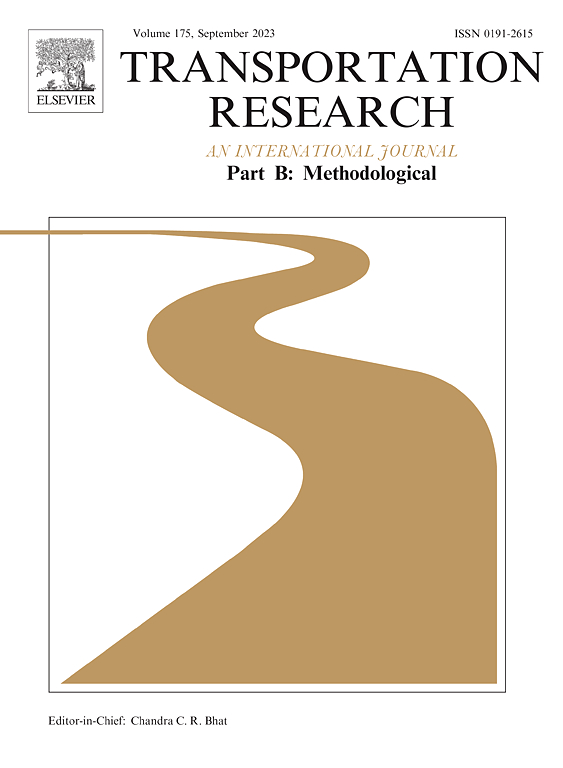Optimizing carbon emissions in green logistics for time-dependent routing
IF 5.8
1区 工程技术
Q1 ECONOMICS
引用次数: 0
Abstract
This paper considers a green vehicle routing problem termed the time-dependent green vehicle routing problem with time windows (TDGVRPTW). The TDGVRPTW is an extension of the green vehicle routing problem with time windows in green logistics. It considers time-dependent vehicle speed and aims to minimize carbon emissions. Since the travel times and carbon emissions between locations depend on the departure time from the starting location, optimizing carbon emissions requires determining the optimal departure times from the depot and customers. This paper presents a branch-price-and-cut (BPC) algorithm to solve the TDGVRPTW. The problem is formulated based on a set-partitioning model. To solve the pricing problem associated with the set-partitioning model, we first define backward non-dominated time-dependent arcs and optimal timed routes. We also introduce three types of routes, forward, backward, and patchwork optimal timed routes, and analyze their characteristics. Then, we introduce a method to adjust the times in backward and patchwork optimal timed routes from the latest to the earliest. We prove that this method guarantees correctness and effectively reduces complexity. We propose a bidirectional labeling algorithm to generate routes. The pricing problem employs state-of-the-art techniques, including limited memory subset row cuts (lm-SRCs), ng-route relaxation, and bucket graphs to enhance the algorithm’s efficiency. The BPC algorithm is tested on a set of instances derived from benchmark cases in the literature. Its various components and pricing strategies are evaluated, and its performance is compared with other algorithms from the literature. The results confirm the effectiveness of the proposed algorithm and its newly designed components in solving the TDGVRPTW.
优化绿色物流中碳排放的时间依赖性路线
本文研究了一个绿色车辆路径问题,称为带时间窗的时变绿色车辆路径问题(TDGVRPTW)。TDGVRPTW是绿色物流中带时间窗的绿色车辆路径问题的延伸。它考虑了与时间相关的车速,旨在最大限度地减少碳排放。由于地点之间的行程时间和碳排放取决于从起始地点出发的时间,因此优化碳排放需要确定从车厂和客户出发的最佳时间。本文提出了一种分支价格切割(BPC)算法来解决TDGVRPTW问题。该问题是基于集划分模型来表述的。为了解决集划分模型中的定价问题,我们首先定义了反向非支配时间相关弧线和最优时间路线。本文还介绍了正向、反向和拼凑三种最优定时路径,并分析了它们的特点。然后,我们介绍了一种反向调整时间的方法,并将最优时间路线从最晚到最早拼凑起来。实验证明,该方法保证了算法的正确性,有效地降低了算法的复杂度。我们提出了一种双向标记算法来生成路由。定价问题采用了最先进的技术,包括有限内存子集行切割(lm- src)、ng路由松弛和桶图,以提高算法的效率。BPC算法在一组来自文献中基准案例的实例上进行了测试。评估了其各个组成部分和定价策略,并将其性能与文献中的其他算法进行了比较。结果证实了该算法及其新设计的组件在求解TDGVRPTW方面的有效性。
本文章由计算机程序翻译,如有差异,请以英文原文为准。
求助全文
约1分钟内获得全文
求助全文
来源期刊
CiteScore
12.40
自引率
8.80%
发文量
143
审稿时长
14.1 weeks
期刊介绍:
Transportation Research: Part B publishes papers on all methodological aspects of the subject, particularly those that require mathematical analysis. The general theme of the journal is the development and solution of problems that are adequately motivated to deal with important aspects of the design and/or analysis of transportation systems. Areas covered include: traffic flow; design and analysis of transportation networks; control and scheduling; optimization; queuing theory; logistics; supply chains; development and application of statistical, econometric and mathematical models to address transportation problems; cost models; pricing and/or investment; traveler or shipper behavior; cost-benefit methodologies.

 求助内容:
求助内容: 应助结果提醒方式:
应助结果提醒方式:


